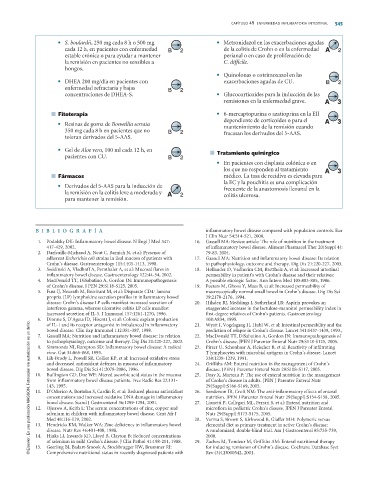Page 540 - medicina-integrativa_compress
P. 540
CAPÍTULO 49 ENFERMEDAD INFLAMATORIA INTESTINAL 545
• S. boulardii, 250 mg cada 8 h o 500 mg • Metronidazol en las exacerbaciones agudas
cada 12 h, en pacientes con enfermedad B B 2 2 de la colitis de Crohn o en la enfermedad A 2 2
A
estable crónica o para ayudar a mantener perianal o en caso de proliferación de
la remisión en pacientes no sensibles a C. difficile.
hongos.
• Quinolonas o cotrimoxazol en las
• DHEA 200 mg/día en pacientes con exacerbaciones agudas de CU. B B 2 2
enfermedad refractaria y bajas B B 2 2
concentraciones de DHEA-S. • Glucocorticoides para la inducción de las
remisiones en la enfermedad grave. A A 3 3
■ Fitoterapia • 6-mercaptopurina o azatioprina en la EII
dependiente de corticoides o para el A A 3 3
• Resinas de goma de Boswellia serrata
mantenimiento de la remisión cuando
350 mg cada 8 h en pacientes que no B B 2 2 fracasan los derivados del 5-AAS.
toleran derivados del 5-AAS.
• Gel de Aloe vera, 100 ml cada 12 h, en
■ Tratamiento quirúrgico
pacientes con CU. B B 2 2
• En pacientes con displasia colónica o en
los que no responden al tratamiento A A 3 3
■ Fármacos médico. La tasa de recidiva es elevada para
la EC y la pouchitis es una complicación
• Derivados del 5-AAS para la inducción de
frecuente de la anastomosis ileoanal en la
la remisión en la colitis leve a moderada y A A 2 2 colitis ulcerosa.
para mantener la remisión.
BIBLIOGRAFÍA inflammatory bowel disease compared with population controls. Eur
J Clin Nutr 54:514-521, 2000.
1. Podolsky DK: Inflammatory bowel disease. N Engl J Med 347: 16. Gassull MA: Review article: The role of nutrition in the treatment
417-429, 2002. of inflammatory bowel disease. Aliment Pharmacol Ther 20(Suppl 4):
2. Darfeuille-Michaud A, Neut C, Barnich N, et al: Presence of 79-83, 2004.
adherent Escherichia coli strains in ileal mucosa of patients with 17. Gassull MA: Nutrition and inflammatory bowel disease: Its relation
Crohn’s disease. Gastroenterology 115:1405-1413, 1998. to pathophysiology, outcome and therapy. Dig Dis 21:220-227, 2003.
3. Swidinski A, Vladhoff A, Pernthaler A, et al: Mucosal flares in 18. Hollander D, Vadherim CM, Brettholz A, et al: Increased intestinal
inflammatory bowel disease. Gastroenterology 122:44-54, 2002. permeability in patient’s with Crohn’s disease and their relatives:
4. MacDonald TT, DiSabatino A, Gordon JN: Immunopathogenesis A possible etiologic factor. Ann Intern Med 105:883-885, 1986.
of Crohn’s disease. J PEN 29:S118-S125, 2005. 19. Peeters M, Ghoos Y, Maes B, et al: Increased permeability of
+
5. Fuss IJ, Neurath M, Boirivant M, et al: Disparate CD4 lamina macroscopically normal small bowel in Crohn’s disease. Dig Dis Sci
propria (LP) lymphokine secretion profiles in inflammatory bowel 39:2170-2176, 1994.
disease: Crohn’s disease LP cells manifest increased secretion of 20. Hilsden RJ, Meddings J, Sutherland LR: Aspirin provokes an
interferon gamma, whereas ulcerative colitis LP cells manifest exaggerated increase in the lactulose-mannitol permeability index in
increased secretion of IL-5. J Immunol 157:1261-1270, 1996. first-degree relatives of Crohn’s patients. Gastroenterology
6. Dionne S, D’Agata ID, Hiscott J, et al: Colonic explant production 108:A834, 1995.
© Elsevier. Es una publicación MASSON. Fotocopiar sin autorización es un delito.
of IL-1 and its receptor antagonist in imbalanced in inflammatory 21. Wyatt J, Vogelsgang H, Hubl W, et al: Intestinal permeability and the
bowel disease. Clin Exp Immunol 112:381-387, 1998. prediction of relapse in Crohn’s disease. Lancet 341:1437-1439, 1993.,
7. Gassull MA: Nutrition and inflammatory bowel disease: Its relation 22. MacDonald TT, DiSabatino A, Gordon JN: Immunopathogenesis of
to pathophysiology, outcome and therapy. Dig Dis 21:220-227, 2003. Crohn’s disease. JPEN J Parenter Enteral Nutr 29:S118-S125, 2005.
8. Simmonds NJ, Rampton SD: Inflammatory bowel disease: A radical 23. Pirzer U, Schonhaar A, Fleischer B, et al: Reactivity of infiltrating
view. Gut 34:865-868, 1993. T lymphocytes with microbial antigens in Crohn’s disease. Lancet
9. Lih-Brody L, Powell SR, Collier KP, et al: Increased oxidative stress 338:1238-1239, 1991.
and decreased antioxidant defenses in mucosa of inflammatory 24. Griffiths AM: Enteral nutrition in the management of Crohn’s
bowel disease. Dig Dis Sci 41:2078-2086, 1996. disease. JPEN J Parenter Enteral Nutr 29:S108-S117, 2005.
10. Buffington GD, Doe WF: Altered ascorbic acid status in the mucosa 25. Dray X, Marteau P: The use of enteral nutrition in the management
from inflammatory bowel disease patients. Free Radic Res 22:131- of Crohn’s disease in adults. JPEN J Parenter Enteral Nutr
143, 1995. 29(Suppl):S166-S169, 2005.
11. D’Odorico A, Bortolan S, Cardin R, et al: Reduced plasma antioxidant 26. Sanderson IR, Croft NM: The anti-inflammatory effects of enteral
concentrations and increased oxidative DNA damage in inflammatory nutrition. JPEN J Parenter Enteral Nutr 29(Suppl):S134-S138, 2005.
bowel disease. Scand J Gastroenterol 36:1289-1294, 2001. 27. Lionetti P, Callegari ML, Ferrari S, et al: Enteral nutrition and
12. Ojuawo A, Keith L: The serum concentrations of zinc, copper and microflora in pediatric Crohn’s disease. JPEN J Parenter Enteral
selenium in children with inflammatory bowel disease. Cent Afr J Nutr 29(Suppl):S173-S175, 2005.
Med 48:116-119, 2002. 28. Verma S, Brown S, Kirkwood B, Giaffer MH: Polymeric versus
13. Hendricks KM, Walker WA: Zinc deficiency in inflammatory bowel elemental diet as primary treatment in active Crohn’s disease:
disease. Nutr Rev 46:401-408, 1988. A randomized, double-blind trial. Am J Gastroenterol 95:735-739,
14. Hinks LJ, Inwards KD, Lloyd B, Clayton B: Reduced concentrations 2000.
of selenium in mild Crohn’s disease. J Clin Pathol 41:198-201, 1988. 29. Zachos M, Tondeur M, Griffiths AM: Enteral nutritional therapy
15. Geerling BJ, Badart-Smook A, Stockbrugger RW, Brummer RJ: for inducing remission of Crohn’s disease. Cochrane Database Syst
Comprehensive nutritional status in recently diagnosed patients with Rev (3)CD000542, 2001.

